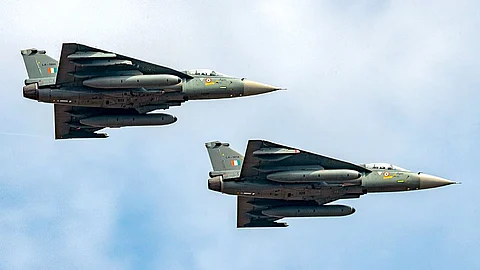
- Home
- About
- Globally Speaking
- Videos
- Podcast
- Geopolitics
- Industry
- SIGN UP

Recent study shows that imports are down by 33 percent and the country’s drive towards achieving self-sufficiency is coming through buying locally produced weapons and systems to boost defence indigenisation.
The Devil, as they say, always lies in the detail. And if research passes muster then India’s drive for Atma Nirbharta in the defence sector is pointing towards paying rich dividends in future.
A recent study conducted by the Stockholm International Peace Research Institute (Sipri) concluded that Arms imports by India decreased by 33 per cent between 2011–15 and 2016–20. Russia was the most affected supplier, although India’s imports of US arms also fell, by 46 per cent. The drop in Indian arms imports seems to have been mainly due to its complex procurement processes, combined with an attempt to reduce its dependence on Russian arms. India is planning large-scale arms imports in the coming years from several suppliers but also pushing ahead with local manufacturing and development of equipment.
It is but natural given the fact that following pathbreaking reforms in the defence sector by the Indian government the country has decided to focus and develop defence products internally and cut down on imports.
The country’s defence minister famously stated that “India cannot be dependent on others for its defence,” and in doing so he awarded the largest Make In India defence contract worth $65 billion to government-owned Hindustan Aeronautical Limited (HAL) to develop and put into action the Tejas MK1A fighter aircraft for the benefit of the Indian Air Force.
A total of 83 light aircraft will now be produced by HAL and this is sending ripples of optimism and excitement among domestic defence manufacturers and international companies who are biting at the bit to set up operations in India given that the government has raised the limit for foreign direct investment to a staggering 74% thus giving them more control in terms of operations and decision making.
The increase in FDI has resulted in the creation of a negative list of 101 items whose imports would be banned (they would be reserved for manufacture and procurement in India). Therefore, all defence tenders of less than $28 million are now reserved for Indian companies. It also corporatises the Ordnance Factory Board (OFB) with the intention of ultimately listing it.
The Tejas order book awarded to HAL is a statement of intent by the government of Indian prime minister Narendra Modi that India is keen to further its vision of Atma Nirbhar Bharat, or self-reliance, towards building a strong and self-sufficient defence eco-system which can provide for the needs of the country’s armed forces.
For the record India had earmarked a sum of INR 70,221 crore - 63% of the military’s capital budget for 2021-22 for buying locally produced weapons and systems to boost defence indigenisation. The allocation is to be used towards the development and purchase of the Tejas LCA (light combat aircraft) Mk-1A jets, light combat helicopters (LCHs), basic trainer aircraft, Arjun Mk-1A tanks, Astra beyond-visual-range missiles, Pinaka rocket systems and anti-tank missiles. The ministry spent a total of INR. 51,000, which amounted to around 58% of the capital budget on domestic purchases.
READ MORE ON INDIA’S REFORMS:
Investors cheer Modi push for reforms to propel growth
MSME reforms set the stage for big manufacturing boom
Explained: The A, B, C of India's farm law reforms
Ongoing reforms will get Indian bureaucracy ready for 21st century challenges
Space sector reforms opens up new market worth billions of dollars
It is true that some of India’s age-old allies who provided defence equipment to New Delhi suffered a reverse due to the country’s bid for self-reliance. Russia was a case in point and even the US whose supply chain took a 46% hit. For the record, India’s top go-to countries for defence supplies was during 2016-20 were Russia (accounting for 49% of India’s imports), France (18%) and Israel (13%), according to the SIPRI report.
But New Delhi has started gaining traction as an exporter of defence equipment as well given that it accounted for 0.2% of the share of global arms exports during 2016-20, putting it at 24th in the world’s list of armed exporters. This ranking illustrated an increase of 228% over India’s export share of 0.1 % during the previous five-year period of 2011-15. Myanmar, Sri Lanka and Mauritius were the beneficiaries of Indian military hardware.
Foreign defence and tech companies are eyeing the Indian defence sector with glee following the pathbreaking reforms. It is being now accepted that the current scenario is ideal for them to step into as they are more comfortable at the thought of transferring their classified intellectual property to Indian subsidiaries.
Global aviation entities like Boeing, Lockheed Martin, Dassault and Airbus took part in the recently concluded Aero India show in a bid to showcase their growing interest in the defence sector. Other defence firms involved in the aviation sector like Thales, BAE Systems and missile manufacturer MBDA were also present to assess the size of the cake and their share of it.
In the meanwhile, the government plans to follow up on their earlier list of 101 negative items with another version that will bar imports in specific categories.
In keeping with its approach of supporting homegrown products Airbus Defence and Space in collaboration with Tata Advanced Systems will receive a purse of $2.5 billion to sell 56 medium transport aircraft for the IAF. These will substitute the Avro-748 planes. This enterprise comes squarely under the Make In India project.
The signs are clear that the Indian defence is turning a corner. With growth being recorded across multiple sectors and the economy swinging higher it was a matter of time for the sector to make a case for itself and announce its intentions with a resounding bang.